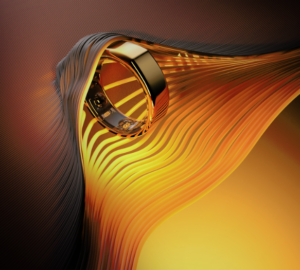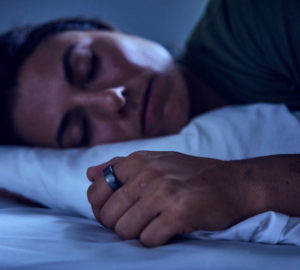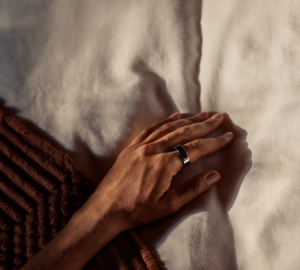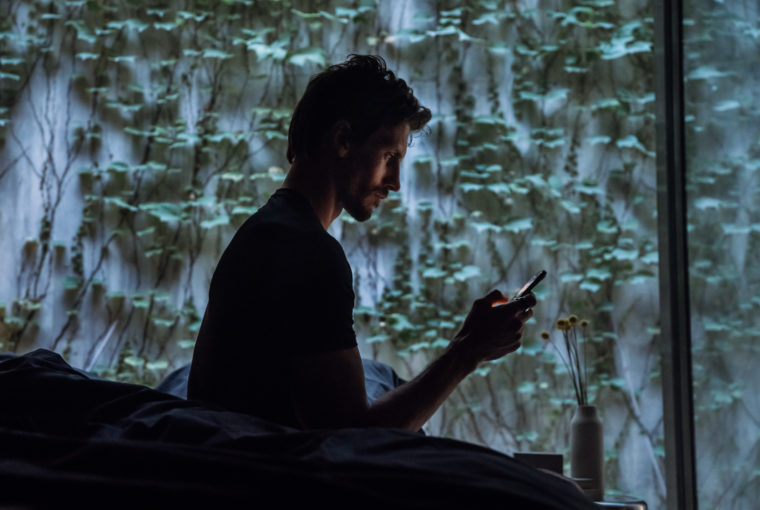As you close your eyes and prepare to doze off, your Oura Ring prepares to track your entire night of shuteye. In the morning, you’ll wake up to in-depth data that shows how long you spent in each stage of sleep, as well as a Sleep Score that tells you at a glance how well you slept. But you’re probably curious: How does the Oura Ring track my sleep — accurately?
Here, we give you a peek into how Oura’s technology, sensors, and design give it the edge in accurately tracking your nightly shuteye.
LEARN MORE: What Are the Stages of Sleep?
Sleep Tracking: Our Focus Since Day One
Unlike other wearables that were originally designed as activity trackers, Oura was engineered to prioritize accurate sleep insights. The Oura Ring delivers research-quality data and has been validated against the gold standard sleep laboratory test—polysomnography (PSG). Here’s what sets Oura apart from other sleep trackers.
Oura is intentionally designed to maximize sleep data quality.
- In the Oura Ring Gen3, PPG is sampled at 50Hz — meaning it completes 50 cycles per second. (PPG stands for “photoplethysmography,” and refers to the infrared LED that measures heart rate, respiration, and heart rate variability at night.)
- The unobtrusive ring design allows you to measure your sleep comfortably, without bright screens or notifications disrupting your sleep.
- Oura’s accelerometer sensor sits on your finger, enabling highly sensitive activity detection for even subtle nighttime movements.
- The ring measures directly from arteries in your finger, rather than the surface capillaries in your wrist. This enables Oura to capture the signal as it leaves the heart, rather than on a delay on the return.
- Oura uses infrared PPG which penetrates deeper than the greenlight PPG in other wearables.
- Unlike single-sided wrist wearables, Oura leverages LEDs on either side of the finger to prioritize the clearest signal.
Oura leverages the best-in-class sleep experts in the world.
- Oura is a company founded in sleep with a dedicated team that understands sleep physiology and is committed to researching the science of sleep. The Oura Ring was designed by experts to not only empower our members to understand their own sleep and health, but also to enable researchers to use it as a tool for advancing our understanding of sleep.
- Oura’s sleep algorithm was tested and trained using machine learning and contains multiple components, including bedtime detection and sleep staging.
- Unlike other sleep-tracking apps, we have made a significant effort in transparency by publishing, in a peer-reviewed scientific journal, the major steps and pipeline of our sleep algorithm, notes Raphael Vallat, PhD, senior machine learning data scientist at Oura.
How Does Oura Know When I’m Asleep?
Many wearables, mobile apps, or mattress sleep trackers rely solely on movement patterns from an accelerometer to determine if you’re asleep or awake. When you move, your device identifies you as awake, when you’re still for long enough, you register as asleep. Oura takes a more sophisticated approach by using a combination of your body temperature and activity patterns for added precision.
Oura is one of the only wearables that directly measures skin temperature. As a result, Oura has the ability to detect how your body temperature naturally drops as you’re falling asleep and rises again just before you wake. Oura picks up on these patterns when you’re headed to bed for the night or if you rest during the day.
Oura additionally has the advantage of a highly sensitive accelerometer to measure your movement. By being located on your finger, Oura is enabled to capture your subtlest movements and detect the differences between things like twitching in a dream, turning over in bed, and getting up for a nighttime trip to the bathroom.
How Does Oura Know What Sleep Stage I’m In?
Once Oura has determined that you’re asleep, it collects an abundance of highly detailed data to generate sleep stage graphs called “hypnograms,” like this:
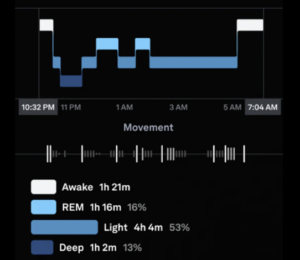
How are hypnograms created? At the end of the night, Oura takes all of your data and divides your sleep into 5 minute intervals. It then classifies your data into sleep stages — awake, light, deep, and REM — by looking for which sleep stage patterns are most dominant in your data. Oura leverages your movement and changes in your heart rate, respiration, and temperature to identify the signatures of each sleep stage.
As you sleep, there are clear patterns that Oura analyzes for each sleep phase.
| Light Sleep | Deep Sleep | REM Sleep |
|
|
|
Keep in mind that even a basic sleep tracking tool can still generate a similar graph, even if it’s using more primitive data or fewer data points to ‘identify’ which stage of sleep you’re in. For example, a mobile app relying solely on your movement patterns might generate a hypnogram that is estimating sleep stages based only on which periods of time you seemed to be moving more (light sleep or awake) vs. less (deep sleep or REM). However, a device like this will have a hard time differentiating between your sleep stages, leveraging only one source of data, your activity.
Similarly, a device with a lower sampling rate than Oura, or fewer data streams (i.e., no temperature), might be able to identify obvious sleep patterns over larger periods of time but is more likely to miss, or misidentify, subtler sleep stage changes.
In short, the more high-quality data that you have, the richer and more accurate your sleep staging will be.
How Does Oura Differ From A Professional Sleep Study?
The main differences between any personal sleep tracker and a professional sleep study are the types of equipment used and the number of nights measured. Although Oura has been validated against the gold standard sleep laboratory test—polysomnography (PSG), it offers the distinct advantage of fewer sensors, more data, and objective analysis.
- Fewer sensors: Oura strikes a balance between capturing accurate data and enabling a natural sleep experience. PSG tests in sleep labs use a full suite of sensors that require wearing equipment on your head, around your eyes, up your nose, and across your body. While these types of sensors can be crucial for identifying major medical conditions, they also disrupt the natural sleeping experience. If you want to more easily optimize your sleep, Oura provides a comfortable, simple solution for personal at-home sleep tracking.
- More data: Because PSG tests are intrusive and expensive, intensive sleep studies usually only capture a few nights of data. On the other hand, Oura allows you to measure your data continuously — night after night — to ensure you capture the full picture of your sleep.
- Objective analysis: PSG sleep stage analysis is a combination of science and craft. It involves individual scorers recording their interpretation of the data. Research has shown that inter-scorer variability is about 82%. This is where Oura has an edge: consistency. The algorithm scores your sleep with the same principles every night, ensuring you can confidently spot long-term trends and changes in your sleep stages, so you don’t settle for just one isolated night of data.
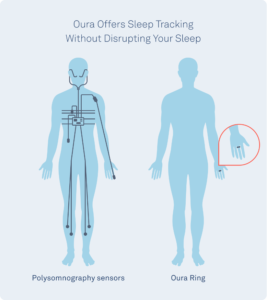
LEARN MORE: Why Sleep Matters
About the Oura Expert
Raphael Vallat, PhD, is a senior machine learning data scientist at Oura. He previously worked as a sleep researcher in the Center for Human Sleep Science at University of California Berkeley (Prof. Matt Walker‘s lab). He has published extensively on the topic of sleep and human health, and his work has been featured in several major news media and podcasts. In his free time, you can find him enjoying precious moments with his amazing wife and daughter, playing music, or hiking with friends.
